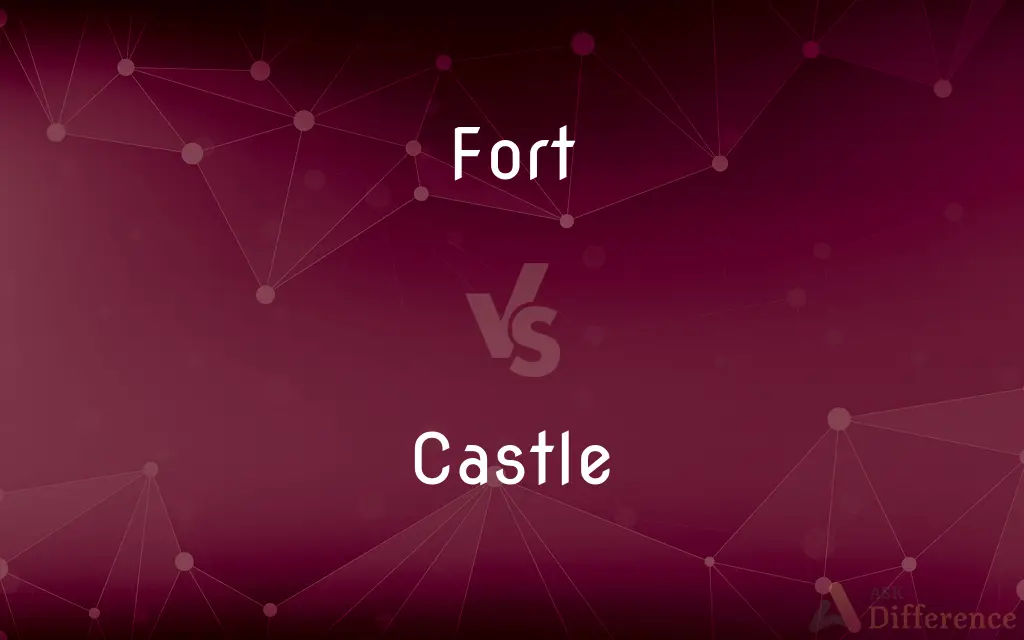Fort vs. Castle — What's the Difference?
By Tayyaba Rehman & Maham Liaqat — Updated on March 11, 2024
A fort is a military stronghold designed for defense in warfare, while a castle is a fortified residence of a lord or noble, often with administrative functions.

Difference Between Fort and Castle
Table of Contents
ADVERTISEMENT
Key Differences
Forts are primarily military establishments focused on strategic defense and offense in warfare, constructed to protect territories and military troops. Castles, on the other hand, serve as fortified residences for nobility or royalty, combining the functions of defense, residence, and sometimes administrative centers.
While forts are built for the specific purpose of military utility and are often temporary or utilitarian in design, castles are designed with a dual purpose: to provide defense against attacks and to serve as opulent homes for their inhabitants, often reflecting the wealth and status of the owner.
Forts are usually simpler in construction and may be made from a variety of materials including earthworks, wood, or stone, depending on the need for permanence and the available resources. Castles, however, are typically constructed with durability in mind, featuring stone walls, moats, drawbridges, and other defensive mechanisms alongside living quarters, halls, and sometimes luxurious amenities.
The strategic location of forts is chosen based on tactical military advantages, such as high ground or key points along trade routes or borders. Castles are often strategically placed as well but also take into consideration the proximity to fertile lands, political significance, and the control of trade routes.
Historically, forts have been used across different cultures and periods for the purpose of military defense and are less commonly used in modern times, replaced by more advanced military bases and installations. Castles, while also of historical significance, have become iconic symbols of medieval Europe, with many preserved as tourist attractions, museums, and cultural heritage sites.
ADVERTISEMENT
Comparison Chart
Primary Function
Military defense and offense
Fortified residence, defense, and administrative center
Design Focus
Utilitarian and strategic
Defense combined with residential and sometimes luxurious amenities
Construction Materials
Earthworks, wood, stone (based on necessity)
Mainly stone, with defensive structures like moats and drawbridges
Location Criteria
Tactical military advantage
Strategic defense, proximity to fertile lands, political or economic significance
Historical Usage
Across various cultures for military purposes
Primarily in medieval Europe as residences for nobility and royalty
Compare with Definitions
Fort
Military stronghold for defense.
The fort was strategically positioned on the hill to oversee the valley.
Castle
Fortified noble residence.
The castle stood as a symbol of the king's authority and wealth.
Fort
Often temporary or utilitarian.
The wooden fort served as a temporary defense against invaders.
Castle
Combines defense with luxury.
Despite its robust walls, the castle featured lavish interiors.
Fort
Focuses on strategic advantage.
Forts are commonly found along borders and key trade routes.
Castle
Often located near valuable resources.
The castle's position allowed control over the fertile lands and river.
Fort
Varied construction materials.
The fort's construction utilized local stone for quick assembly.
Castle
Primarily stone construction.
The castle's thick stone walls have withstood centuries.
Fort
Less common in modern times.
With advancements in warfare, forts have evolved into military bases.
Castle
Preserved as cultural heritage.
The ancient castle now serves as a museum and tourist attraction.
Fort
A fortified building or strategic position
The city was guarded by a ring of forts
Castle
A castle is a type of fortified structure built during the Middle Ages predominantly by the nobility or royalty and by military orders. Scholars debate the scope of the word castle, but usually consider it to be the private fortified residence of a lord or noble.
Fort
A fortified place or position for the stationing of troops.
Castle
A large fortified building or group of buildings with thick walls, usually dominating the surrounding country.
Fort
A permanent army post.
Castle
A fortified stronghold converted to residential use.
Fort
A fortified defensive structure stationed with troops.
Castle
A large ornate building similar to or resembling a fortified stronghold.
Fort
Any permanent army post.
Castle
A place of privacy, security, or refuge.
Fort
(historical) An outlying trading-station, as in British North America.
Castle
(Games) See rook2.
Fort
A structure improvised from furniture, bedding, etc., for playing games.
The kids built a fort out of chairs and pillows.
Castle
To move the king in chess from its own square two empty squares to one side and then, in the same move, bring the rook from that side to the square immediately past the new position of the king.
Fort
To create a fort, fortifications, a strong point, or a redoubt.
Castle
To place in or as if in a castle.
Fort
A strong or fortified place; usually, a small fortified place, occupied only by troops, surrounded with a ditch, rampart, and parapet, or with palisades, stockades, or other means of defense; a fortification.
Detached works, depending solely on their own strength, belong to the class of works termed forts.
Castle
(Games) To move (the king in chess) by castling.
Fort
A fortified military post where troops are stationed
Castle
A large residential building or compound that is fortified and contains many defences; in previous ages often inhabited by a nobleman or king. Also, a house or mansion with some of the architectural features of medieval castles.
Fort
A fortified defensive structure
Castle
(chess) An instance of castling.
Fort
Gather in, or as if in, a fort, as for protection or defense
Castle
A rook; a chess piece shaped like a castle tower.
Fort
Enclose by or as if by a fortification
Castle
(shogi) A defense structure in shogi formed by defensive pieces surrounding the king.
Fort
Station (troops) in a fort
Castle
(obsolete) A close helmet.
Castle
(dated) Any strong, imposing, and stately palace or mansion.
Castle
(dated) A small tower, as on a ship, or an elephant's back.
Castle
The wicket.
Castle
(transitive) To house or keep in a castle.
Castle
To protect or separate in a similar way.
Castle
(obsolete) To make into a castle: to build in the form of a castle or add (real or imitation) battlements to an existing building.
Castle
To move the king 2 squares right or left and, in the same turn, the nearest rook to the far side of the king. The move now has special rules: the king cannot be in, go through, or end in check; the squares between the king and rook must be vacant; and neither piece may have been moved before castling.
Castle
To create a similar defensive position in Japanese chess through several moves.
Castle
(cricket) To bowl a batsman with a full-length ball or yorker such that the stumps are knocked over.
Castle
A fortified residence, especially that of a prince or nobleman; a fortress.
The house of every one is to him castle and fortress, as well for his defense againts injury and violence, as for his repose.
Our castle's strengthWill laugh a siege to scorn.
Castle
Any strong, imposing, and stately mansion.
Castle
A small tower, as on a ship, or an elephant's back.
Castle
A piece, made to represent a castle, used in the game of chess; a rook.
Castle
To move the castle to the square next to king, and then the king around the castle to the square next beyond it, for the purpose of covering the king.
Castle
A large and stately mansion
Castle
A large building formerly occupied by a ruler and fortified against attack
Castle
(chess) the piece that can move any number of unoccupied squares in a direction parallel to the sides of the chessboard
Castle
Interchanging the positions of the king and a rook
Castle
Move the king two squares toward a rook and in the same move the rook to the square next past the king
Common Curiosities
Can a castle be a fort?
While a castle can have fort-like defenses, its primary function as a residence and sometimes an administrative center distinguishes it from a purely military fort.
How do forts and castles differ in design?
Forts are designed with a focus on military utility, often temporary and utilitarian, whereas castles are designed for defense and residence, featuring more elaborate and durable structures.
What is the main purpose of a castle?
The main purpose of a castle is to serve as a fortified residence for nobility or royalty, offering protection and sometimes serving as an administrative center.
Are all castles luxurious?
Not all castles were built with luxury in mind; some were more functional, depending on the resources and intentions of their builders.
What defines a fort?
A fort is defined as a military establishment designed primarily for defense in warfare.
What materials are used to build forts and castles?
Forts can be made from earthworks, wood, or stone, while castles are predominantly constructed from stone to ensure durability and defense capabilities.
Why are castles often located near valuable resources?
Castles are strategically placed near valuable resources to control fertile lands, ensure economic prosperity, and maintain political significance.
Are forts still used today?
Traditional forts are less common in modern military strategies, replaced by advanced military installations and bases.
What role do castles play in history?
Castles played a significant role as power symbols for nobility, centers of governance, and defensive structures in medieval times.
How were forts used in historical warfare?
Historically, forts were used to protect territories, troops, and strategic locations from enemy attacks.
How did the construction of forts evolve over time?
The construction of forts evolved with advancements in military technology and strategies, adapting to new forms of warfare.
Why are castles important in medieval history?
Castles are important in medieval history as they symbolize the feudal system, military strategy, and the social hierarchy of the time.
What is the significance of a castle's location?
A castle's location was strategically chosen for defense, control over lands, and sometimes to symbolize power and wealth.
What is a famous example of a fort?
The Alamo in Texas is a famous example of a fort with significant historical importance.
Can castles still be found today?
Many castles have been preserved and can be visited, serving as tourist attractions, museums, and cultural heritage sites.
Share Your Discovery

Previous Comparison
Hindi vs. BengaliNext Comparison
Kerning vs. TrackingAuthor Spotlight
Written by
Tayyaba RehmanTayyaba Rehman is a distinguished writer, currently serving as a primary contributor to askdifference.com. As a researcher in semantics and etymology, Tayyaba's passion for the complexity of languages and their distinctions has found a perfect home on the platform. Tayyaba delves into the intricacies of language, distinguishing between commonly confused words and phrases, thereby providing clarity for readers worldwide.
Co-written by
Maham Liaqat












































